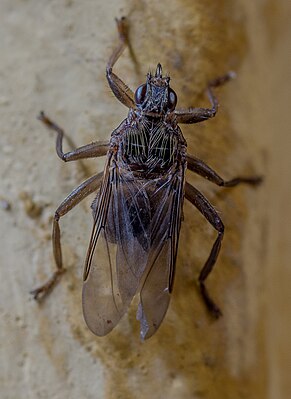Pigeon louse fly
| Pigeon louse fly | ||||||||||
|---|---|---|---|---|---|---|---|---|---|---|

Pigeon louse fly ( Pseudolynchia canariensis ) |
||||||||||
| Systematics | ||||||||||
|
||||||||||
| Scientific name | ||||||||||
| Pseudolynchia canariensis | ||||||||||
| ( Macquart , 1839) |
The pigeon louse fly , ( Pseudolynchia canariensis ), is a species of louse flies that occurs almost worldwide . It is a parasitic blood-sucking insect that attacks birds, especially pigeons .
description
Pigeon louse flies have the typical, flattened body shape of the louse flies, it is monochrome brownish in color. The species is fully winged and capable of flight. It reaches a body length of 5 to 6 millimeters, the clear (hyaline) wings with a length of about 4.5 to 7.5 millimeters protrude over the end of the abdomen. As is typical for all related species, the rear edge of the head is somewhat truncated and connects closely to the trunk. As a representative of the genus Pseudolynchia , it can be recognized by only a single cross vein (the rm vein) in the wing in connection with the missing ocelles . In addition, the rear edge of the scutellum is straight, not edged, with angular rear angles. The palps of this species are quite long and the front half is covered by soft, white hairs. The fine hairs (microtricha) on the wings do not reach the second anal vein. In addition, the forehead between the antennae is about as wide as the distance to the eyes, it is significantly shorter than it is wide.
distribution
The species is native to the tropics and subtropics of the Old World, from Africa to Southeast Asia. From there it was introduced into the New World, probably with domesticated pigeons, and is widespread there today, especially in South America. In Europe it occurs regularly only in the Mediterranean region. From there it was introduced with migratory birds to northern and central Europe, without being at home there. A second species of the genus occurs in southern Europe with Pseudolynchia garzettae Rondani, 1879.
The pigeon louse fly has not yet been detected in Germany or England, but there is evidence from Sweden.
Biology, host spectrum
The species sucks blood on birds as hosts in both sexes. It is not picky about its hosts; species from 33 bird genera are listed in eight orders. The pigeons (Columbiformes) are clearly preferred . In America it occurs exclusively on pigeons, almost always domesticated house pigeons .
As is typical for all louse flies, the species does not have a free larval stage. Females always keep a single larva in their abdomen, where they are nourished with a milk-like secretion. Finally, a full-grown larva of the last stage is deposited, which pupates almost immediately afterwards in the last larval skin as a puparium. Pupation takes place on the ground. The newly hatched flies then look for new bird hosts. Since they do not fly very quickly, it is believed that they are primarily ambulance hunters. In a pinch, when no bird is available, they occasionally sting mammals, including humans. The sting is described as painful.
Taxonomy and systematics
The genus Pseudolynchia Bequaert, 1926 comprises five species worldwide. The tribe Olfersini to which the species belongs does not, according to genetic analyzes, form a common clade with the species of the subfamily Ornithomyinae; this suggests that the transition to blood sucking on birds must have occurred twice within the louse flies.
The species was first described as Olfersia canariensis in 1840 by Justin Pierre Marie Macquart in his treatment of the Diptera in the work Historie Naturelle des Iles Canaries (Volume 2, Part 2, edited by Philip Barker Webb and Sabin Berthelot). Synonyms include Olfersia testacea Macquart, 1843, Olfersia rufipes Macquart, 1847, Olfersia maura Bigot, 1885, Lynchia simillima Speis, 1904.
Meaning as a vector
Pigeon lice flies are known as a vector of Haemoproteus columbae (Haemosporidia, Apicomplexa ), a unicellular parasite that primarily harms nestlings of pigeons. In addition, they carry feather mites of the genera Myialges and Ornithocheyletia sucked on their bodies from host to host, as well as various feather lice belonging to the jaw lice ( phoresia ).
Web links
Literature and Sources
- TC Maa (1966): On the genus Pseudolynchia Bequaert. Pacific Insects Monograph 10: 125-138.
- TC Maa (1969): A revised checklist and concise host index of Hippoboscidae (Diptera). Pacific Inseccts Monograph 20: 261-299.
- Frederik Torp Petersen, Rudolf Meier, Sujatha Narayanan Kutty, Brian M. Wiegmann (2007): The phylogeny and evolution of host choice in the Hippoboscoidea (Diptera) as reconstructed using four molecular markers. Molecular Phylogenetics and Evolution 45: 111-122. doi: 10.1016 / j.ympev.2007.04.023 .
- AM Hutson: Keds, Flat-Flies and Bat-Flies (Hippoboscidae and Nycteribiidae). Handbooks for the Identification of British Insects vol 10 part 7. edited by the Royal Entomological Society of London, 1984.
- William H. Kern: Pigeon Louse Fly or Pigeon Fly, Pseudolychia canariensis (Macquart) (Insecta: Diptera: Hippoboscidae). US Department of Agriculture, UF / IFAS Extension Service, University of Florida, Institute of Food and Agricultural Sciences (IFAS) document EENY-307, 2003.
- F. Macchioni, M. Magi, F. Mancianti, S. Perrucci (2005): Phoretic association of mites and mallophaga with the pigeon fly Pseudolynchia canariensis. Parasite 12 (3): 277-279. doi: 10.1051 / parasite / 2005123277 (open access).